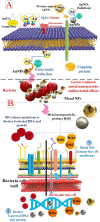Spotlight on therapeutic efficiency of green synthesis metals and their oxide nanoparticles in periodontitis
- PMID: 38183090
- PMCID: PMC10770920
- DOI: 10.1186/s12951-023-02284-5
Spotlight on therapeutic efficiency of green synthesis metals and their oxide nanoparticles in periodontitis
Abstract
Periodontitis, one of the most prevalent dental diseases, causes the loss of bone and gum tissue that hold teeth in place. Several bacteria, commonly present in clinically healthy oral cavities, may induce and perpetuate periodontitis when their concentration rises in the gingival sulcus. Antibacterial effect against various Gram-negative and Gram-positive bacteria, including pathogenic and drug-resistant ones, has been shown for several distinct transient metal and metal oxide NPs. Therefore, NPs may be used in biomedicine to treat periodontal problems and in nanotechnology to inhibit the development of microorganisms. Instead of using harmful chemicals or energy-intensive machinery, biosynthesis of metal and metal oxide nanoparticles (NPs) has been suggested. To produce metal and metal oxide NPs, the ideal technique is "Green" synthesis because of its low toxicity and safety for human health and the environment. Gold NPs (AuNPs) appear to be less toxic to mammalian cells than other nanometals because their antibacterial activity is not dependent on reactive oxygen species (ROS). AgNPs also possess chemical stability, catalytic activity, and superior electrical and thermal conductivity, to name a few of their other advantageous characteristics. It was observed that zinc oxide (ZnO) NPs and copper (Cu) NPs exhibited discernible inhibitory effects against gram-positive and gram-negative bacterial strains, respectively. ZnO NPs demonstrated bactericidal activity against the microorganisms responsible for periodontitis. Medications containing magnetic NPs are highly effective against multidrug-resistant bacterial and fungal infections. The titanium dioxide (TiO2) NPs are implicated in elevating salivary peroxidase activity in individuals diagnosed with chronic periodontitis. Furthermore, specific metallic NPs have the potential to enhance the antimicrobial efficacy of periodontitis treatments when combined. Therefore, these NPs, as well as their oxide NPs, are only some of the metals and metal oxides that have been synthesized in environmentally friendly ways and shown to have therapeutic benefits against periodontitis.
Keywords: Antibacterial; Green synthesize; Metal nanoparticles; Metal oxide Nanoparticles; Periodontitis.
© 2023. The Author(s).
Conflict of interest statement
The authors declare that they have no competing interests.
Figures






Similar articles
-
Green nanotechnology advances: green manufacturing of zinc nanoparticles, characterization, and foliar application on wheat and antibacterial characteristics using Mentha spicata (mint) and Ocimum basilicum (basil) leaf extracts.Environ Sci Pollut Res Int. 2023 May;30(21):60820-60837. doi: 10.1007/s11356-023-26827-3. Epub 2023 Apr 11. Environ Sci Pollut Res Int. 2023. PMID: 37039921
-
Exploring the potential of metal and metal oxide nanomaterials for sustainable water and wastewater treatment: A review of their antimicrobial properties.Chemosphere. 2023 Sep;335:139103. doi: 10.1016/j.chemosphere.2023.139103. Epub 2023 Jun 2. Chemosphere. 2023. PMID: 37271472 Review.
-
Mycogenic Synthesis of Extracellular Zinc Oxide Nanoparticles from Xylaria acuta and Its Nanoantibiotic Potential.Int J Nanomedicine. 2020 Nov 2;15:8519-8536. doi: 10.2147/IJN.S271743. eCollection 2020. Int J Nanomedicine. 2020. PMID: 33173290 Free PMC article.
-
Eco-friendly Mycogenic Synthesis of ZnO and CuO Nanoparticles for In Vitro Antibacterial, Antibiofilm, and Antifungal Applications.Biol Trace Elem Res. 2021 Jul;199(7):2788-2799. doi: 10.1007/s12011-020-02369-4. Epub 2020 Sep 8. Biol Trace Elem Res. 2021. PMID: 32895893
-
Eco-friendly zinc oxide nanoparticle biosynthesis powered by probiotic bacteria.Appl Microbiol Biotechnol. 2025 Jan 29;109(1):32. doi: 10.1007/s00253-024-13355-4. Appl Microbiol Biotechnol. 2025. PMID: 39878901 Free PMC article. Review.
Cited by
-
Green synthesis of NiO and NiO@graphene oxide nanomaterials using Elettaria cardamomum leaves: Structural and electrochemical studies.Heliyon. 2024 Sep 30;10(20):e38613. doi: 10.1016/j.heliyon.2024.e38613. eCollection 2024 Oct 30. Heliyon. 2024. PMID: 39449702 Free PMC article.
-
An In Vitro Study of Antioxidant, Anti-inflammatory, and Cytotoxic Effects of Echinacea-Mediated Zinc Oxide Nanoparticles.Cureus. 2024 Jul 25;16(7):e65354. doi: 10.7759/cureus.65354. eCollection 2024 Jul. Cureus. 2024. PMID: 39184651 Free PMC article.
-
Potential role of metal nanoparticles in treatment of peri-implant mucositis and peri-implantitis.Biomed Eng Online. 2024 Oct 12;23(1):101. doi: 10.1186/s12938-024-01294-0. Biomed Eng Online. 2024. PMID: 39396020 Free PMC article. Review.
-
Antimicrobial Activity of Nano-GeO2/CTAB Complex Against Fungi and Bacteria Isolated from Paper.Int J Mol Sci. 2024 Dec 18;25(24):13541. doi: 10.3390/ijms252413541. Int J Mol Sci. 2024. PMID: 39769304 Free PMC article.
-
Adsorptive Removal of Amoxicillin Using Green-Synthesized SiNH2@FeNP Nanocomposite: Characterization, Optimization, and Modeling.ACS Omega. 2025 Jun 11;10(24):25951-25961. doi: 10.1021/acsomega.5c02529. eCollection 2025 Jun 24. ACS Omega. 2025. PMID: 40584322 Free PMC article.
References
-
- Sudiono J, et al. Bactericidal and cytotoxic effects of Erythrina fusca leaves aquadest extract. Dent J Majal Kedokt Gigi. 2013;46:9–13. doi: 10.20473/j.djmkg.v46.i1.p9-13. - DOI
Publication types
MeSH terms
Substances
LinkOut - more resources
Full Text Sources

